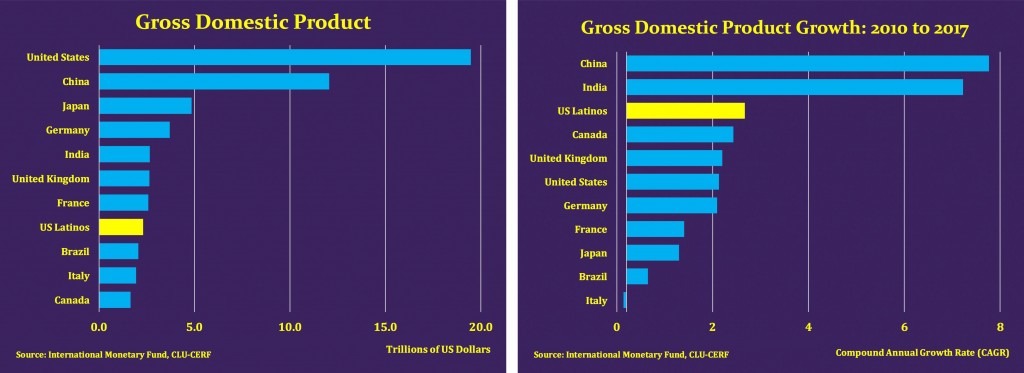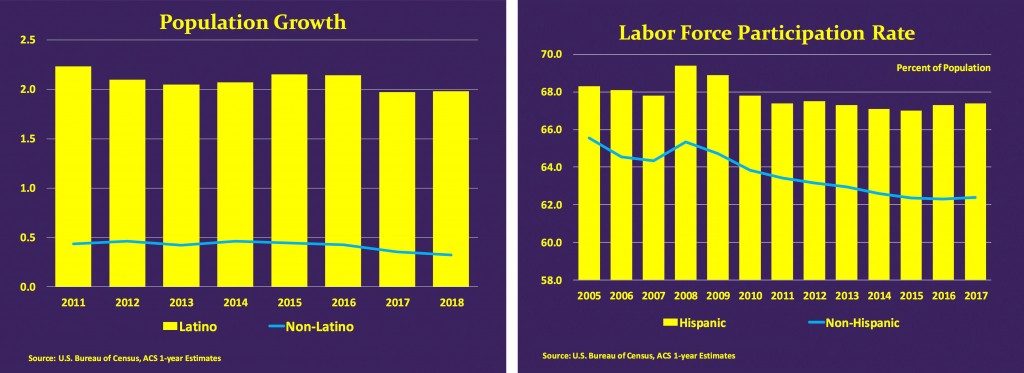CERF Blog
This is from our First Annual LDC U.S. Latino GDP Report which was published on Thursday, September 26th, at the L’Attitude Conference in San Diego:
Executive Summary
This report seeks to provide a factual view of the large and growing economic contribution of Latinos living in the United States. In order to do this, we make Latino-specific calculations of major GDP components aggregated across more than 70 industrial sectors of economic activity. This is a detailed, bottom up construction of the total economic impact of Latinos.
As a summary statistic for the performance of Latinos in the United States, the Latino GDP is impressive indeed. The total economic output (or GDP) of Latinos in the United States was $2.3 trillion in 2017, up from $2.1 trillion in 2015 and $1.7 trillion in 2010. If it were an independent country, the Latino GDP would be the eighth largest in the world, larger even than the GDPs of Brazil, Italy or Canada and more than 45 percent larger than Russia.
Latino GDP is remarkable not only for its size but also for its growth. Among the ten largest GDPs in the world, the Latino GDP is the third fastest growing and the single fastest growing of the fully developed economies. The growth rate of the broader U.S. economy ranks sixth, well behind the Latino GDP.
The single largest contributor to rapid Latino GDP growth from 2010 to 2017 was personal consumption. Comparing compound annual growth rates, Latino real consumption grew 72 percent faster than non-Latino consumption over that period.
There are important demographic drivers of the Latino GDP. Two that stand out are population growth and Labor Force Participation. Population growth among U.S. Latinos is currently six times faster than population growth among non-Latinos. Latinos, including both U.S. born individuals and immigrants, are significantly more likely to be actively working or seeking work than non-Latinos. U.S. Latino labor force participation (LFP) is 67.4 percent, fully five percentage points higher than non-Latino. Despite being only 18 percent of the U.S. population, Latinos are responsible for 82 percent of the growth of the U.S. labor force since the Financial Crisis.
The importance of labor force growth can hardly be overstated. According to Federal Reserve economists, the number of people retiring in the U.S. is forecasted to increase more than 15 percent in the next three years. The rate of retirement will peak in 2022 at approximately 345,000 people retiring each month.
According to traditional growth accounting, the United States needs to add more than 300,000 jobs per month in order to maintain its post World War II historic average growth rate. Combined with the anticipated loss of nearly 350,000 workers per month due to retirement, the U.S. will need close to 650,000 new workers entering the labor force each month, or 8 million new workers added each year, in order to maintain its dominant position in the global economy and to meet commitments made to the Country’s retirees. In other words, the U.S. is confronting a dangerous shortage of workers. Fortunately, Latinos are already well on their way to rescuing the U.S. from this demographic time bomb.
Data also show that Latinos have a strong health profile. Not only are they expected to live longer lives (with lower death rates from multiple causes), but they also practice healthy habits. From an economic perspective, supporting this demographic is a key investment for controlling health care costs and for the growth of the U.S. economy overall.
Given the strong health profile, robust population growth and high Latino labor force participation detailed here, along with strong increases in educational attainment and income and personal consumption growth among Latinos, we expect that the economic growth premium that Latinos enjoy relative to Non-Latinos in the U.S. will be maintained in the years ahead. Latinos currently are and will increasingly become a critical foundation of support for the new American Economy.



